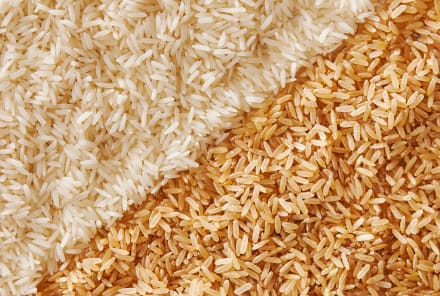Advertisement
The Four Types Of Digestion In Ayurveda & How They Can Help Heal Your Gut


Ayurveda, the 5,000-year-old science of life from India that concerns itself with holistic health and well-being, refers to digestion as agni—the Sanskrit word for "fire." There are four distinct "types" of agni, and the goal is to get your agni into balance.
When your digestion is unbalanced for an extended period of time, toxins known as ama start to build up in your system. When ama, which is a result of poor agni, accumulates, you start to feel a whole legion of side effects, including indigestion, sluggishness, bloating and gas, and more. Only when we are digesting efficiently can we feel energized and ready to take on the day.
The four types of digestion.
Knowing what kind of agni you have can tell you a lot about the imbalances you're experiencing. Let's take a deeper dive into how to recognize each type of agni and balance them out using food and lifestyle shifts in order to achieve healthy digestion.
Sama agni
Balanced agni, known as "sama agni," corresponds to great digestion, the type of agni we should strive for. Physical signs of a balanced agni are not only great digestion but also an ability to adapt to changes in weather or seasons. In terms of emotional signs, people with a balanced agni are able to think clearly, enjoy steady moods, and are better at dealing with stress and other hurdles that come their way—all other types of agni are the result of imbalances we need to remedy.
Visham agni
Visham agni is irregular digestion, most often experienced by vata- (the dosha defined by space and air) dominant individuals, or those experiencing a vata imbalance. Their digestive fire is erratic, changing from fast-burning to slow, as if air is blowing on it. Their moods, feelings, and hunger can change at the drop of a hat, and they may suffer from constipation or "rabbit dropping"–type waste. These symptoms can also manifest as gas pain, indigestion, and even dry skin. Visham agni can be soothed by eating more clear foods such as broths, soups, and ghee.
Tikshna agni
Tikshna agni or sharp digestion is mostly associated with pitta (fire and water dosha) mind-body types, which can be understood as fighting fire with fire. This fire is fast-burning and overactive. Although it might seem ideal as we liken it to a "fast-burning metabolism" within a Western approach, too much fire in the belly leads to a hotheaded, fiery mood and can burn down nutrients before your body has a chance to assimilate them. These symptoms can manifest as insatiable hunger, heartburn, and hot flashes. This can also lead to runny, oily waste material that burns—no need to explain that one in everyday terms! Soothe tikshna agni with cooling foods such as fennel, mint teas, and fruit smoothies.
Manda agni
Lastly, manda agni or slow digestion is likened to kapha (water and earth dosha) mind-body types and can be described as if building a fire with damp branches—it is slow-burning and weak and easily leads to weight gain and lethargy and renders large, heavy, soft waste material. These symptoms can manifest as nausea, weight gain, and cold, clammy skin. Manda Agni can be brought back in balance by eating two to three smaller meals throughout the day and privileging spicy curries and dried fruits.
Best practices for taking care of your agni.
As you can see, digestion, like everything else in ayurveda, depends heavily on the individual and their environment. There are, however, some universal ways everyone can take care of their agni.
You'll notice that they're about much more than what you eat; you could have the healthiest foods in the world, but if you eat them in a stressed-out state, you'll reduce the effectiveness of your digestion and lose some of their benefits. (Hence why many ayurvedic practitioners believe in good digestion and a bad diet rather than a good diet and bad digestion.) Here are the top do's and don'ts for fueling a healthy agni:
Do:
- Eat mindfully, without distractions.
- Take the time to enjoy your food and be grateful for it.
- Listen to your body, and stop eating when you're satisfied but not overly full (efficient digestion needs room to take place!).
- Opt for long, slow cooking techniques to make your food easier to digest and less taxing on the body.
Don't:
- Take too much raw food and cold drinks, which are hard to digest if you don't have adequate agni.
- Eat dinner too late in the day (especially a large, hard-to-digest meal) since it makes it hard to digest fully before bed.
- Eat a large a meal that's hard to digest too early in the day since it doesn't give your body the chance to fire up properly.
And with that, you're ready to start building a lively, healthy digestive fire and burn away the sticky, cold, wet, heavy qualities of ama in your system.
Watch Next
Enjoy some of our favorite clips from classes
Enjoy some of our favorite clips from classes
What Is Meditation?
Mindfulness/Spirituality | Light Watkins
Box Breathing
Mindfulness/Spirituality | Gwen Dittmar
What Breathwork Can Address
Mindfulness/Spirituality | Gwen Dittmar
The 8 Limbs of Yoga - What is Asana?
Yoga | Caley Alyssa
Two Standing Postures to Open Up Tight Hips
Yoga | Caley Alyssa
How Plants Can Optimize Athletic Performance
Nutrition | Rich Roll
What to Eat Before a Workout
Nutrition | Rich Roll
How Ayurveda Helps Us Navigate Modern Life
Nutrition | Sahara Rose
Messages About Love & Relationships
Love & Relationships | Esther Perel
Love Languages
Love & Relationships | Esther Perel












